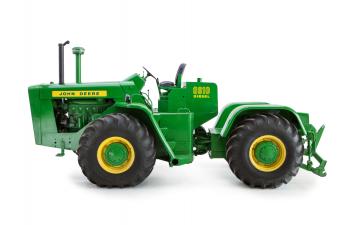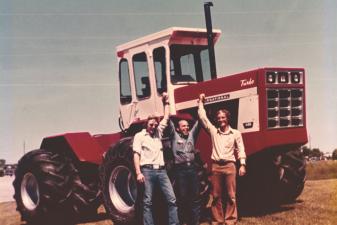Weld, Build, Repeat: The Innovative Power of the Garage

This article was originally published as a feature in the Ageless Iron section of Successful Farming magazine, where Lee Klancher is a regular contributor.
A few months ago, I took my rusty but trusty old Toyota FJ40 out to pick up some parts and made it only a few blocks before it stopped dead on a busy street down the hill from my house. As cars piled up behind me, the old six-cylinder cranked but refused to fire.
My immediate problem was solved when a couple guys ran out to help me push the forty off the street, and I towed it back to my house so I could begin the time-honored practice of standing in my garage scratching my head while pondering the issue.
Solving problems is the soul of innovation, and struggling with my mundane issue led me to think about innovations great and small that emerged from the fertile breeding ground of the garage. The list is a long one, and includes vital contributions such as the telephone, the portable X-ray machine, the metal detector, and Barbie.
While part of this phenomena can be attributed to the simple fact that the garage is typically the place in the household with the most space available for welders, benches, and printed circuit board diagrams, the garage is always a place where practical solutions to daily problems happen on a recurring basis. And the essence of innovation is simple problem-solving.
I personally can attest to the problem-solving power of the garage. I’ve spent a good part of my life fixing motorcycles and old trucks in spaces that ranged from a jam-packed apartment complex single garage stall in St. Paul to an old chicken coop at a rental house in rural Wisconsin.
After I bought my first house, I built a proper garage. In the back of garage, I walled off and finished out an office where I started the best problem-solving exercise of my life: leaving my long-time day job as a book editor to figure out how to make a living as a freelance writer and a photographer.
The solution I found is to publish books about things I love, one of which is mechanical innovation. While that solution has been my greatest accomplishment, I take nearly as much joy solving the mundane issues that populate a gearhead’s life, whether it’s tuning a derailleur on a mountain bike, rebuilding the front driveline on a 40-year-old truck, or chasing an electrical problem on a vintage Ducati.
My gearhead tendencies naturally lead me to a great fascination with mechanical innovation, and I have the good fortune of doing work that requires studying, photographing, and interviewing people the people whose hands-on solutions changed our society (often in a garage).

Max Hazan gathers the goods to assemble one of his masterworks. This collection of parts is going to get a whole lot of media attention once it’s organized. Photo by David K. Browning
The agricultural innovation world is filled with great stories of garage innovation, ranging from the group of John Deere engineers locked into a converted butcher shop to build the New Generation tractor to a young engineering student by the name of Paul Nystuen who designed the International 4366 while shuttered in a garage in Fargo, North Dakota, with two veteran metal workers.
Perhaps my all-time favorite garage tale is that of Douglass Steiger. In the mid-1950s, he and his father, John, and brother, Maurice were struggling to keep their farm in northern Minnesota afloat during a string of several years of rainy weather that destroyed crops and profits along with them.
The three were able to make ends meet by contracting with heavy equipment, but the farm required two or three of them to work the land. They thought that if they had a bigger tractor, John could work the land (which he loved to do) and Douglass and Maurice could make cash contracting.
Inspired by the Wagner tractor, a large four-wheel-drive tractor introduced in the 1950s, the trio applied for a loan with their local banker. They gave the banker two options: borrow $20,000 for a Wagner tractor or give them a long for $10,000 to build their own.
After a bit of thought, the banker told them he’d give them the money to build one.
So that’s exactly what the Steiger boys did.
In a barn converted to a shop, they spent the fall of 1956 and winter of 1957 welding together a hand-designed frame with used engine and driveline parts. They built the power divider from scratch.
By spring 1957, John was happily plowing with his new big tractor, and the boys were off contracting, just as planned.
That tractor worked effectively for roughly two decades, and today it lives at the Bonanzaville Museum in Fargo, North Dakota. And the brand, as you know, became a world leader in high-tech four-wheel-drive tractors.
The sheer amount of imagination and courage required for this feat is hard to fathom, particularly in today’s world where problems tend to be solved by overnight parts deliveries and express service people.
Perhaps even more amazing was the vision of the Steiger family. While photographing the second Steiger built by the family—a smaller machine with a similar layout—I was poking and prodding a machine with the long-time head of product marketing for Case IH, Mitch Kaiser. His profession has been living and breathing four-wheel-drive machines since the 1980s.

1968 Model 2200. The V carved in the front of the grille designated the V-6 engine carried under the hood. Photo by Lee Klancher
Mitch sat in the seat of the old rig and reached for the controls. After a bit, he turned to me with a smile. He couldn’t believe how well laid out the controls on the machine were—everything laid right to hand and placed where it should be.
Properly placing controls took tractor manufacturers decades to get right. Sit on a 1920s or 1940s tractor, and it won’t take long to find a lever in an odd place that’s hard to reach, or a control that is awkward to use. It wasn’t until Human Factors Engineering was publicized that tractor manufacturers began to build machines that integrated with people.
For the Steigers, they knew they’d be on that machine a few weeks after it was done. And the idea of making it comfortable to use came naturally, just like the solution to a daily problem was to build what was needed.
Garage innovation, at its finest.
To read more stories of garage innovation, check out the “related books” linked below.








